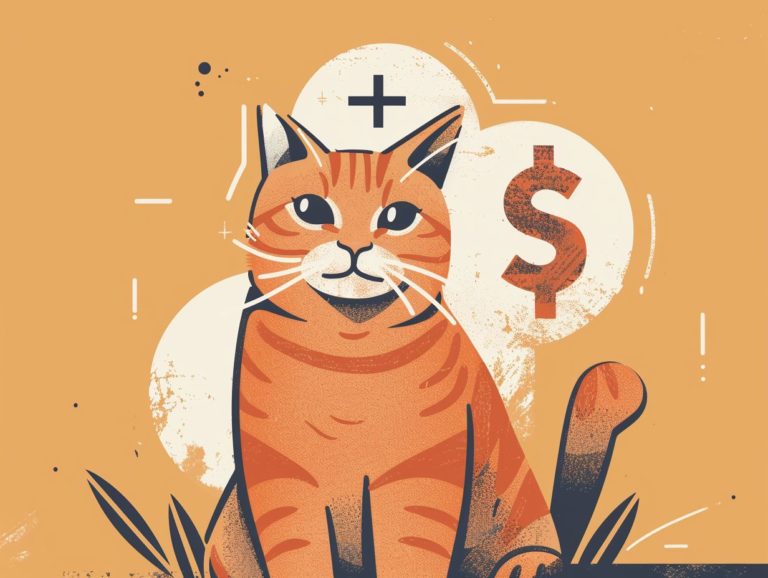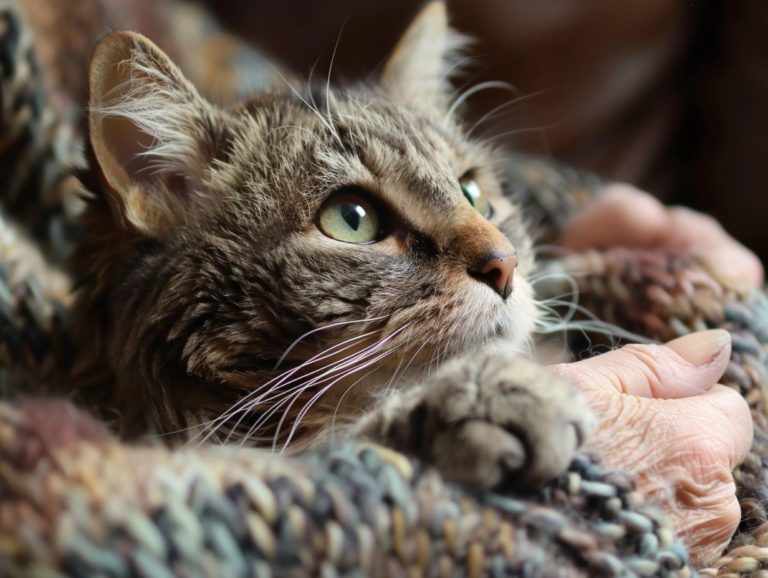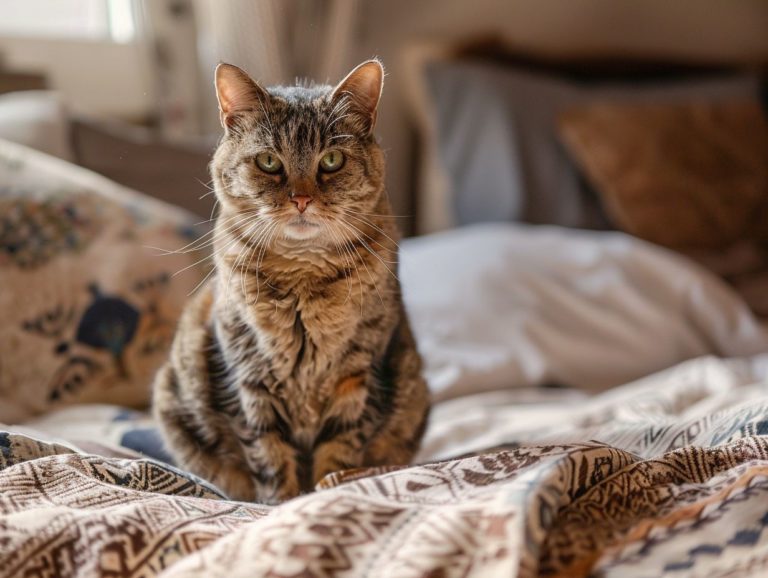How To Switch Insurance Providers For Your Senior Cat
This guide offers a detailed exploration of acquiring and altering insurance for senior cats. It includes topics such as understanding insurance coverage for senior cats, what is included and excluded in coverage, when to consider changing insurance providers, signs indicating your current insurance is inadequate, steps to take, factors to investigate and compare in insurance plans, and a systematic approach to obtaining insurance for your senior cat and transitioning between providers. The guide also addresses how to safeguard your cat’s health during the transition period and prevent any lapses in coverage.
Key Takeaways:
Understanding Insurance Coverage for Senior Cats
ManyPets customers should understand the available insurance coverage for senior cats to ensure they can afford the necessary care for their pets in their later years without facing a significant financial burden. ManyPets offers a range of pet insurance coverage options for senior cats, including comprehensive medical care, emergency treatment, and coverage for chronic conditions.
Customers can select from various policy terms, such as lifetime coverage, and different deductible levels to align with their budget and their cat’s healthcare requirements. Most pet insurance policies come with waiting periods before coverage takes effect, underscoring the importance of enrolling senior cats early to avoid any gaps in coverage.
ManyPets streamlines the claims process, allowing customers to easily submit and track claims online or through their customer service hotline for prompt reimbursement.
What is Covered and What is Not
Senior cat health coverage under a ManyPets pet insurance policy includes veterinary visits, treatments, medications, and surgeries, while also outlining exclusions. Being aware of these details in advance can prevent policyholders from facing surprises during vet visits.
ManyPets offers comprehensive coverage for senior cat health, alleviating owners from the financial burden of various health conditions. Pre-existing conditions are typically excluded from the policy, emphasizing the importance of enrolling senior cats when they are healthy to maximize benefits.
Specific procedures or services may have benefit caps, underscoring the need for a thorough understanding of the insurance policy for senior cats.
When is it Time to Switch Insurance Providers?
Determining whether it is time to switch pet insurance providers for a senior cat like ManyPets insurance depends on the insurance provider’s ability to meet the pet’s changing needs and the pet owner’s evolving service and coverage expectations.
A clear indication that it may be time to switch to a different insurance provider is if you are consistently frustrated with the claims processing time or if your claims are unjustly denied. Difficulty in reaching responsive and helpful customer service representatives, or noticing that coverage limitations and exclusions are negatively impacting your pet’s care, are also signs that a new provider may be necessary.
If the veterinary provider network in your area is limited in size and quality, switching to an insurance provider with a larger and higher-quality network may be beneficial.
Signs That Your Current Provider is Not Meeting Your Needs
Recognizing signs that your current pet insurance provider, like ManyPets, may not be the ideal choice for your senior cat can prompt you to consider switching to a more suitable provider that meets your pet’s requirements. Red flags include:
- Delays in processing claims, especially for essential treatments for your senior cat
- High deductibles for each treatment
- Limited coverage for routine vet visits and preventative care
- Complex, overly restrictive policy terms that hinder accessing the entitled benefits in full
Researching and Comparing Insurance Providers
To find the ideal coverage for your aging cat’s changing health needs, the most effective approach is to conduct research and compare various pet insurance policies, including ManyPets, using platforms such as Pawlicy Advisor.
Exploring different insurers and utilizing comparison platforms enables you to assess the specifics of the coverage, premium prices, rate of reimbursement, and enrollment process. Platforms like Pawlicy Advisor provide the opportunity to compare multiple providers simultaneously, simplifying the decision-making process.
Understanding the specific coverage and exclusion details of each policy is crucial to ensure that your aging cat receives comprehensive medical care without facing financial strain. It is important to take the time to comprehend the fine print and consider factors such as pre-existing conditions, waiting periods, and annual benefit limits in order to customize a policy according to your pet’s needs.
Important Factors to Consider
When researching pet insurance providers for a senior cat, such as ManyPets, the most important factors to consider are coverage options, reimbursement rates, policy terms, and the reputations of insurance companies.
It is crucial to investigate the coverage options offered by different insurers, as this can significantly impact the quality of benefits received. Some policies may exclude coverage for pre-existing conditions, which can greatly diminish the policy’s overall utility. Additionally, it is essential to understand the reimbursement process some insurers may directly pay the veterinarian, while others may require you to pay upfront and then seek reimbursement.
Evaluating insurance company ratings can provide insight into their financial stability and customer satisfaction levels. Carefully reviewing the policy terms is vital, paying attention to any exclusions, waiting periods, and annual limits that could affect your ability to file a claim.
Steps to Switching Insurance Providers
- Begin by reviewing the terms and conditions of your current pet insurance policy to check for any penalties or refund policies.
- Contact your current provider to start the cancellation process, specifying the effective date.
- Research various pet insurance options to select the most suitable one for your senior cat’s requirements.
- Compare different plans based on coverage, premium costs, benefit limits, and additional features.
- Once you have chosen a provider and plan, enroll with the new pet insurance company by submitting the necessary documents and payment information.
- Monitor the transition closely to prevent any coverage gaps for your senior cat and ensure a seamless switch.
Preparing for the Switch
Switching to a new pet insurance provider for seniors, like ManyPets, for your cat involves several steps to ensure a smooth transition. Begin by reviewing your old policy to understand its coverage and limitations.
Next, gather your pet’s medical records, including vaccination history, previous illnesses, and current health issues, as this information is essential for the new provider to assess your pet’s health accurately.
Familiarize yourself with key pet insurance terms like deductibles, premiums, and coverage limits to make informed decisions when selecting a new policy.
Finally, contact the new pet insurance provider to initiate the enrollment process, ensuring you have all necessary documentation ready for a seamless transition.
How to Cancel Your Current Policy
To cancel your existing ManyPets pet insurance policy for senior cats and other pets, you need to contact the company, understand the cancellation conditions, and transition to a new insurance policy.
Policyholders should initiate the cancellation process by contacting ManyPets customer service via phone or email. The cancellation of your policy can be immediate or scheduled for your policy’s renewal date. You will be required to provide your policy details and reason for cancellation. It is crucial to grasp ManyPets’ cancellation policies, including any potential penalties and timeframes for cancellation.
Additionally, you should explore new insurance options for your senior cat and ensure there is no gap in coverage by aligning the start of your new policy with the cancellation date of the old one.
Enrolling with a New Provider
When enrolling with a new pet insurance provider after switching from ManyPets for a senior cat, the process involves selecting a plan, understanding the vet network, and submitting the appropriate documentation for enrollment.
Once you have chosen the best pet insurance plan for your senior cat, the next step in the enrollment process is to carefully assess the veterinarian network of the insurance provider. Ensure that the veterinarians and clinics in the network are conveniently located and provide quality care that meets the needs of your cat. For more details on navigating insurance claims, check out this helpful article on advocating for your senior cat.
Upon verifying the compatibility of the veterinarian network, gather all the necessary documentation required for enrollment, such as the medical history of your cat, details of the previous insurance, and any specific health conditions. Be prepared to provide accurate information to facilitate a smooth enrollment process.
Managing Your Senior Cat’s Health during the Switch
Strategies for taking care of a senior cat’s health when switching insurance policies include:
- Ensuring continued access to veterinary care
- Understanding insurance coverage for pre-existing conditions and treatment options for senior cats
- Grasping reimbursement for treatable illnesses to cater to long-term support and treatment needs
Tracking your cat’s health and scheduling regular vet visits is crucial. Review your new insurance policy to comprehend coverage related to pre-existing conditions and treatment options. Regular vet check-ups are essential for monitoring your senior cat’s health, detecting potential illnesses early, and providing preventative care. Prioritize selecting an insurance provider that offers flexibility for vet visits and treatment plans, along with coverage for a wide range of conditions. Understand how reimbursement for treatable illnesses operates to ease financial burdens while focusing on your cat’s health.
Continuing Care and Coverage
It is essential to ensure continuous care and coverage for your senior cat from ManyPets during an insurance switch to maintain their overall health and access to veterinary services, as well as to facilitate prompt reimbursement for covered conditions.
Proactive care for your senior cat’s health, including regular vet visits, can help detect any issues early, improving your cat’s quality of life and enhancing the chances of receiving reimbursements for covered treatments. Learn how to choose the right senior cat insurance policy to ensure comprehensive coverage for your furry friend.
It is crucial to verify coverage for pre-existing conditions during the insurance switch period to avoid unexpected costs. ManyPets offers flexible coverage that may encompass pre-existing conditions, alleviating financial stress and making it easier to care for your senior cat.
Tips for a Smooth Transition
When switching insurance providers for senior cats, such as transitioning to ManyPets, it is important to follow these tips to ensure a smooth process:
- Identify coverage gaps
- Seek assistance from customer service
- Enroll early to prevent any interruptions in coverage
During the transition, it is crucial to carefully evaluate the medical history and current health status of the senior cat to determine the necessary coverage under the new plan. Conducting a thorough comparison of different insurance policies can help in finding an affordable policy that meets the specific needs of your senior cat. Be sure to inquire about any waiting periods or policies regarding pre-existing conditions to avoid any unexpected issues in the future.
Avoiding Gaps in Coverage
Ensuring continuous coverage for your senior cat with ManyPets during an insurance switch involves careful planning to manage waiting periods, understand waiting period policies, coordinate enrollment timelines, and maintain uninterrupted policy coverage for consistent care.
One effective strategy when transitioning insurance is to align the start of your new policy with the end of your current coverage period to minimize any gaps in protection for your cat.
It is essential to comprehend the enrollment process with the new provider and facilitate clear communication between the new insurer, your bank, and the previous insurer to prevent any coverage lapses for your senior cat.
Frequently Asked Questions
How do I know if it’s time to switch insurance providers for my senior cat?
If you notice that your current insurance provider is not covering certain health issues or treatments for your senior cat, or if your premiums have significantly increased, it may be time to consider switching providers.
What steps should I take when switching insurance providers for my senior cat?
First, you should research and compare different insurance providers to find one that offers better coverage and pricing. Then, before canceling your current policy, make sure there is no lapse in coverage by coordinating the end of your current policy with the start of your new one.
Will my senior cat’s pre-existing conditions be covered by the new insurance provider?
It depends on the specific insurance provider and their policies. Some may offer coverage for pre-existing conditions, while others may not. Make sure to carefully review the terms and conditions of the new policy before making the switch.
How long does it take to switch insurance providers for my senior cat?
The process can vary depending on the insurance provider and the policies involved. Some may require a waiting period before coverage begins, while others may have a seamless transition. It’s best to check with the new provider for an estimated timeline.
Can I negotiate better rates or coverage when switching insurance providers for my senior cat?
Yes, it is possible to negotiate better rates or coverage when switching insurance providers. It’s always worth asking if there are any discounts or special offers available for senior cats. Additionally, make sure to review the policy thoroughly and negotiate any changes or additions that you feel are necessary.
Will my senior cat have to go through a medical exam or screening when switching insurance providers?
It depends on the insurance provider and their policies. Some may require a medical exam or screening for new policyholders, while others may not. Make sure to ask the new provider about their requirements before making the switch.



